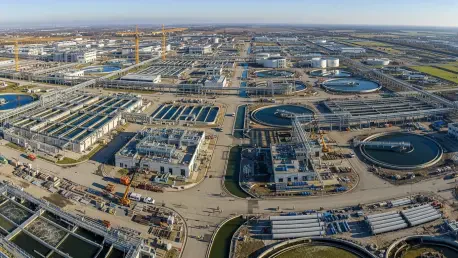Setting the Stage for Texas Water Challenges
In the sprawling landscapes of Texas, a silent crisis brews beneath the surface as rapid urbanization and population surges strain aging water infrastructure to its breaking point, creating an urgent need for innovative solutions. The City of San Marcos, a microcosm of this statewide challenge, has embarked on an $80 million water reclamation project, signaling a pivotal moment for water management strategies across the Lone Star State. This market analysis delves into the implications of this ambitious endeavor, examining how it reflects broader trends in the Texas water infrastructure sector. With population growth outpacing existing systems, the urgency to innovate and invest in sustainable solutions has never been more critical. This exploration aims to uncover the market dynamics, emerging patterns, and future projections that could shape water resource management for growing communities.
Diving into Market Trends and Data in Texas Water Infrastructure
Population Growth Fuels Demand for Scalable Solutions
The Texas water infrastructure market is experiencing unprecedented pressure due to explosive population growth, particularly in suburban hubs like San Marcos. Over the next decade, urban expansion is expected to increase wastewater management needs by nearly 30% in key regions, pushing cities to adopt scalable facilities as a core strategy. The San Marcos project, with an initial capacity of 2 million gallons per day and the potential to expand to 8 million, exemplifies this trend toward adaptable infrastructure. Such designs not only address immediate demands but also mitigate the risk of costly overhauls as communities grow. Market data indicates that scalable water projects are becoming a priority, with over 60% of new municipal contracts in Texas incorporating future-proof elements to handle long-term growth.
Innovative Construction Approaches Reshape Project Timelines
A notable shift in the Texas water infrastructure sector is the adoption of progressive design-build methods, which prioritize speed and collaboration to meet tight deadlines. In San Marcos, construction of interim facilities is set to begin in early 2026, with the permanent plant targeted for substantial completion by August 2028. This accelerated timeline, supported by temporary wastewater systems during construction, reflects a broader market movement toward efficiency-driven approaches. Industry reports suggest that progressive design-build contracts have surged by 25% in the state over the past few years, driven by the need to keep pace with urban development. While this method reduces delivery times, it also demands precise coordination to avoid cost overruns or operational hiccups, a challenge that contractors must navigate carefully.
Funding Models Evolve with Public-Private Partnerships
Funding mechanisms for water infrastructure in Texas are undergoing a transformation, with public-private partnerships emerging as a viable solution to financial constraints. The San Marcos initiative stands out with its cost-sharing agreement between the city and residential developers, aligning infrastructure development with homebuilding schedules. This model not only alleviates municipal budget pressures but also sets a precedent for collaborative financing, with market analysts predicting that similar arrangements could account for 40% of funding for water projects in Texas by 2030. However, the complexity of aligning stakeholder interests poses risks, such as delays in contributions or mismatched priorities. The trend underscores a growing recognition that innovative funding is essential to sustain large-scale water projects amid fiscal challenges.
Legislative Support and Industry Investments Signal Market Growth
Statewide legislative actions are bolstering the Texas water infrastructure market, with a recent allocation of $20 billion to combat an impending water crisis marking a significant commitment to resource management. This funding is expected to catalyze a wave of projects over the next five years, creating a robust pipeline for contractors and engineers. Additionally, industry moves, such as a major San Antonio-based construction firm acquiring a specialized contractor to focus on water developments, highlight the sector’s attractiveness to large players. Market projections indicate a compound annual growth rate of 8% for water infrastructure investments in Texas through 2027, driven by both public funding and private sector interest. These developments point to a maturing market poised for innovation and expansion.
Reflecting on Insights and Strategic Pathways
Looking back, this analysis of the Texas water infrastructure market through the lens of San Marcos’s $80 million project reveals a landscape defined by urgency, innovation, and collaboration. The examination highlighted how population-driven demand spurred scalable designs, while progressive construction methods reshaped project execution. Funding partnerships and substantial legislative support further underscored the market’s evolution, positioning water management as a critical area of growth. For stakeholders, the path forward involves embracing flexible infrastructure planning to anticipate future needs, adopting efficient construction practices to meet pressing timelines, and exploring hybrid funding models to share financial burdens. As Texas navigates these challenges, the strategic focus shifts toward integrating technological advancements, such as smart water systems, to enhance sustainability. These steps offer a blueprint for communities and industry leaders to build resilient water networks capable of supporting the state’s dynamic growth trajectory.









